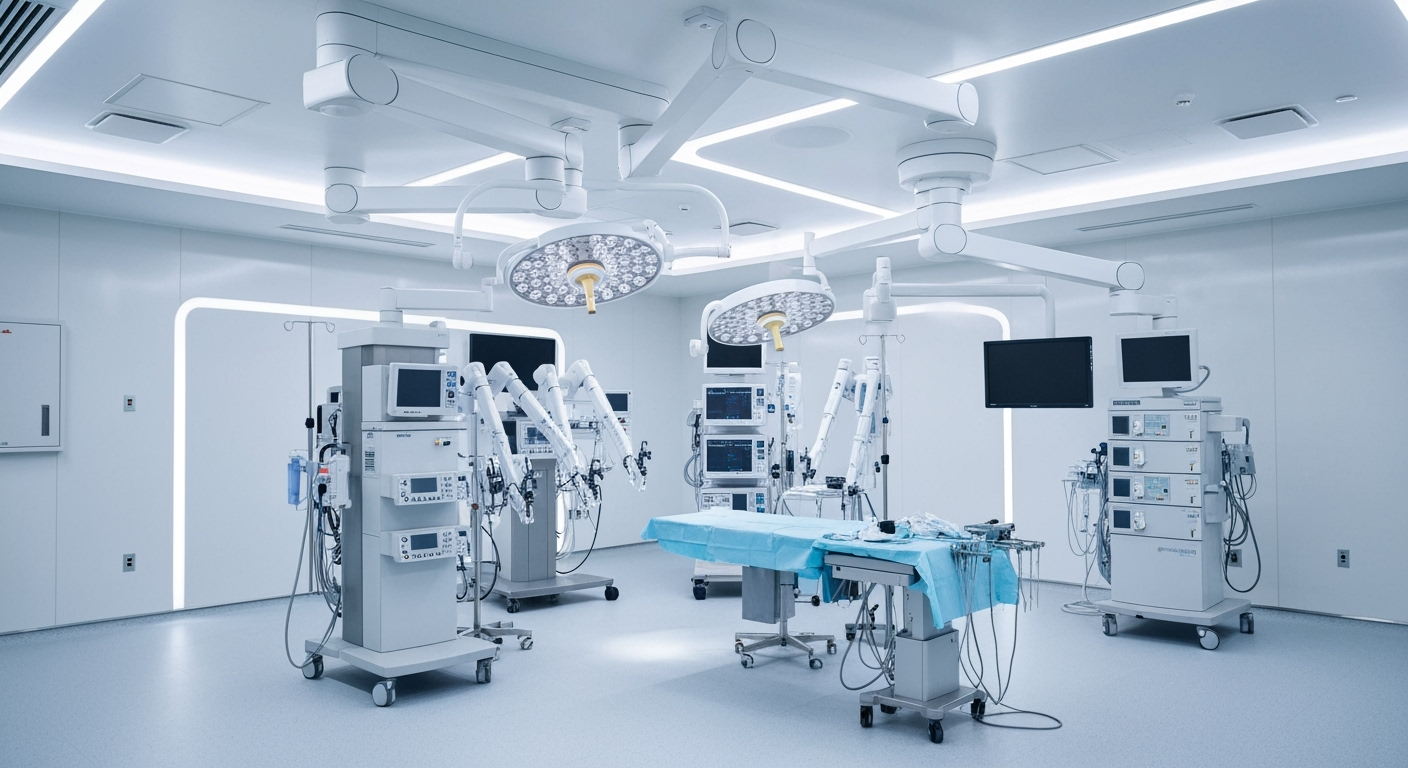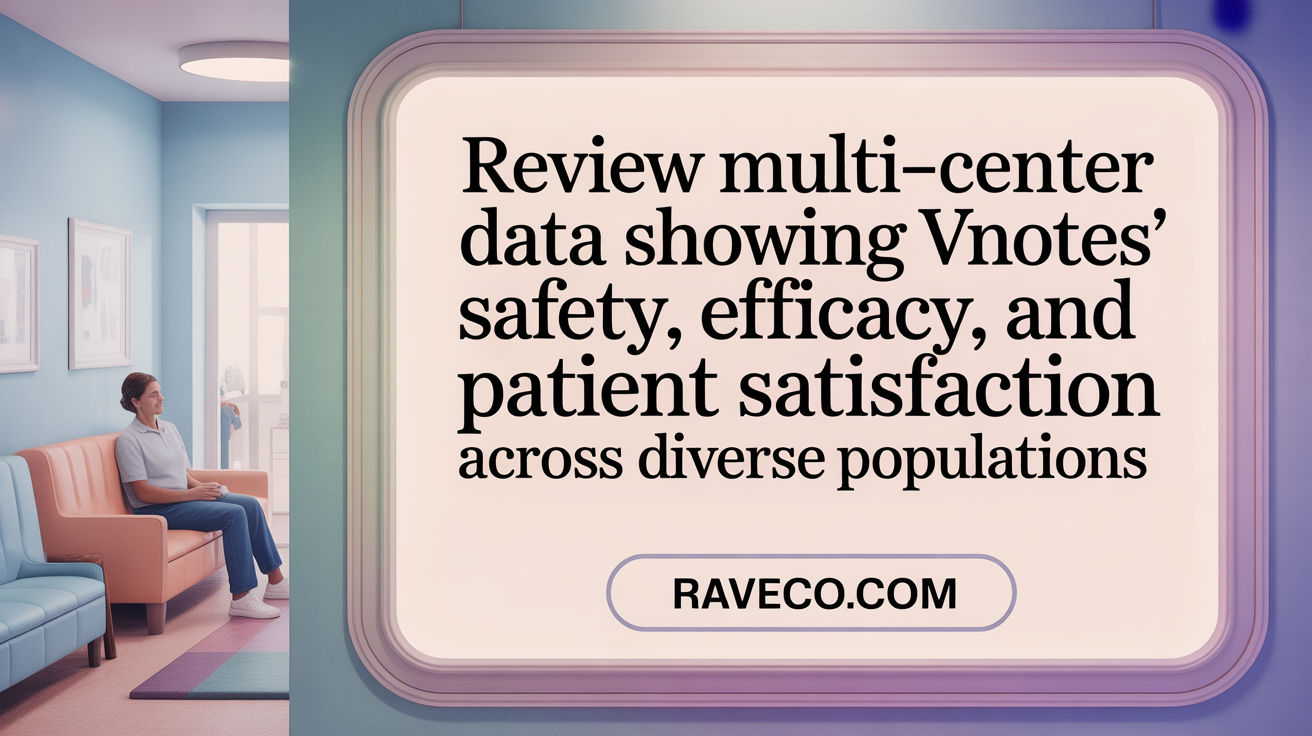Recognizing the Right Time to Address Female Infertility: Key Indicators and Expert Care in Queens

Introduction to vNOTES and Its Scientific Significance
Vaginal natural orifice transluminal endoscopic surgery (vNOTES) represents a significant advancement in minimally invasive gynecologic surgery. By combining endoscopic techniques with natural orifice access, vNOTES offers a scarless alternative to traditional hysterectomy procedures. This article delves into the scientific and clinical foundations underlying vNOTES, explores the surgical technique in detail, reviews comparative outcomes with traditional methods, examines patient selection criteria, and highlights emerging robotic technologies that further enhance this innovative approach.
Understanding the vNOTES Technique: Foundations and Surgical Methodology
What is the vNOTES technique for hysterectomy?
vNOTES, or vaginal natural orifice transluminal endoscopic surgery, is a minimally invasive approach used in gynecologic surgery, notably for hysterectomy. It harnesses the natural opening of the vagina to access the pelvic cavity, eliminating the need for external skin incisions. The procedure begins with a circumferential incision around the vaginal fornix to perform a colpotomy, which provides access to the pelvic organs.
Once the pelvis is accessed, a specialized port, often the GelPoint V-Path device, is inserted through the vaginal fornix. This port acts as a seal, allowing for the introduction of miniature surgical instruments and a high-definition camera while maintaining insufflation of the pelvic space.
The insufflation creates a working space, improving visualization and facilitating tissue manipulation. Using endoscopic techniques, the surgeon can precisely dissect tissues, ligate blood vessels, and separate the uterus from surrounding structures. The uterus is then removed through the vaginal canal, similar to traditional vaginal hysterectomy but with enhanced visualization and control.
The key advantages of vNOTES include minimized postoperative pain due to fewer incisions, improved cosmetic outcomes owing to the absence of abdominal scars, and potential reductions in operative time and complications. The approach also preserves vaginal function and reduces recovery time.
Compared to previous natural orifice surgeries like LESS (laparoendoscopic single-site surgery) and NOTES (natural orifice transluminal endoscopic surgery), vNOTES specifically utilizes the vaginal route—considered preferable because it offers lower contamination risk, better visualization, and easier access. This evolution in minimally invasive gynecologic surgery aims to overcome some technical challenges associated with LESS and NOTES, making vNOTES a feasible, safe, and effective method for hysterectomy.
In summary, vNOTES combines the benefits of endoscopic visualization with the natural access of the vaginal route, facilitating complex gynecologic procedures with reduced invasiveness and improved patient outcomes.
Step-by-Step Surgical Procedure of vNOTES Hysterectomy

Surgical preparation
The vNOTES hysterectomy begins with patient positioning under general anesthesia. The surgeon ensures that the patient is optimally placed to facilitate access and visualization through the vaginal route. The necessary surgical instruments and specialized access device, such as the GelPoint V-Path, are prepared and sterilized.
Incision and port placement
A small, approximately 2 cm, incision is made in the posterior fornix of the vagina. This entry point allows access to the pelvic cavity. The GelPoint V-Path device is then inserted through the vaginal incision, creating a sealed passage that enables the placement of instruments and a high-definition camera.
Use of GelPoint V-Path device
The GelPoint V-Path device provides a stable, flexible conduit for surgical instruments. It maintains pneumoperitoneum within the pelvis when insufflated, and its design allows for maneuvering of multiple instruments simultaneously.
Insufflation and visualization
The surgeon insufflates the pelvic cavity with carbon dioxide to create working space, similar to laparoscopic procedures. The high-definition camera inserted through the GelPoint allows clear visualization of pelvic structures, facilitating precise dissection.
Dissection of uterosacral ligaments and uterine vessels
Using energy devices, such as bipolar coagulators, the surgeon begins the dissection by securing and cutting the uterosacral ligaments to provide uterine mobility. The uterine arteries are identified, coagulated, and transected, ensuring adequate blood flow control. The surgeon carefully mobilizes the bladder and ureters to prevent injury.
Removal of uterus and adnexa if applicable
After detaching all supporting structures and pedicles, the uterus is carefully mobilized. If ovarian or tubal removal is indicated, these are excised and removed through the vaginal route within a specimen bag to reduce contamination.
Specimen extraction
The uterus with or without attached adnexa is extracted through the vaginal canal, often using contained tissue extraction techniques. This minimizes tissue spillage and maintains a clean surgical field.
Hemostasis and closure
The surgeon ensures all bleeding points are securely sealed. The vagina is inspected and closed, often with absorbable sutures. No external incision is needed, resulting in a scarless surgery. Postoperative assessments confirm proper hemostasis and recovery.
Clinical Evidence: Safety and Effectiveness of vNOTES Hysterectomy
Recent clinical studies underscore the safety and strong efficacy profile of vNOTES hysterectomy. Data from multiple trials reveal that vNOTES procedures are generally non-inferior to conventional laparoscopic surgeries, with some studies suggesting even lower complication rates. These advantages include less postoperative pain, quicker recovery times, and shorter hospital stays.
The safety profile reflects manageable risks such as bleeding, injury to the ureters, bladder perforations, and hematomas. Surgeons can substantially reduce these risks through meticulous dissection, early vessel control, and use of high-definition visualization tools. Proper training is essential, as the procedure demands familiarity with endoscopic techniques and vaginal anatomy.
vNOTES has shown particular promise for specific patient groups. Obese women, individuals with prior abdominal surgeries, and cases involving larger uteri benefit from the approach’s minimally invasive nature and improved access. Its capacity for complete exploration of the peritoneal cavity also supports safer surgeries.
With ongoing research and increased standardization of techniques, vNOTES is progressively expanding into more complex settings, including oncological surgeries. The consensus from current evidence affirms that when performed by experienced surgeons, vNOTES offers a safe, effective, and patient-friendly alternative to traditional methods.
In summary, clinical outcome data advocate for vNOTES as a reliable option with benefits like minimized postoperative pain, rapid return to daily activities, and comparable or favorable complication profiles compared to existing surgical options.
Comparative Analysis: vNOTES versus Traditional and Laparoscopic Hysterectomy

How does vNOTES hysterectomy compare with laparoscopic and traditional hysterectomy approaches?
vNOTES hysterectomy, a minimally invasive technique, integrates vaginal, laparoscopic, and LESS procedures. It primarily aims to reduce postoperative discomfort and improve cosmetic outcomes. Compared to traditional abdominal hysterectomy, which involves a large incision, vNOTES offers no external scars and typically shorter recovery times.
When matched against conventional laparoscopic hysterectomy, vNOTES has demonstrated shorter operative durations and decreased postoperative pain. Many studies, including randomized controlled trials, highlight that patients undergoing vNOTES experience less pain, recover faster, and return to daily activities sooner.
Furthermore, vNOTES has shown a comparable safety profile with low complication rates, similar to or better than those observed in traditional laparoscopy and abdominal approaches. Its natural orifice access reduces the risks associated with abdominal entry, such as wound infections and hernias.
Preliminary cost-effectiveness analyses suggest that vNOTES may be more economical than robotic-assisted surgeries, mainly due to shorter operative times and hospital stays. This approach also reduces the need for extensive port placements and assistance, simplifying the procedure.
Studies validate that vNOTES is a feasible and safe alternative, especially suitable for women with smaller or normal-sized uteri. As surgical techniques and training evolve, vNOTES could potentially reverse the decline in vaginal hysterectomy rates by providing a less invasive and more patient-centered option.
Advantages of Scarless Hysterectomy with vNOTES: Beyond Aesthetics

What are the advantages of scarless hysterectomy techniques like vNOTES?
vNOTES, or vaginal natural orifice transluminal endoscopic surgery, has revolutionized hysterectomy procedures by providing a fully scarless approach. Since it uses the natural vaginal route, there are no external incisions or visible scars, markedly enhancing cosmetic outcomes.
This technique also offers several clinical benefits. Patients report less postoperative pain, which translates into greater comfort and a quicker return to daily activities. The minimally invasive nature of vNOTES reduces the risk of wound infections and hernias that can occur with larger abdominal incisions.
Moreover, the easier recovery process enables women to resume work and normal routines sooner. Hospital stays are generally shorter, often just a couple of days, and some patients go home within 24 hours.
In addition to functional advantages, vNOTES enhances patient satisfaction and overall quality of life. The absence of external scars not only improves appearance but also boosts psychological well-being, especially important for women concerned about body image.
Finally, because the procedure minimizes tissue trauma and preserves pelvic support structures, the risk of wound-related complications such as hernias or dehiscence is decreased. All these factors make vNOTES an appealing alternative to traditional hysterectomy methods, combining efficacy with superior aesthetic and recovery outcomes.
| Benefit | Description | Additional Notes |
|---|---|---|
| No external scars | Complete scarlessness from natural orifice approach | Results in superior cosmetic outcomes |
| Reduced pain | Less postoperative discomfort | Facilitates faster mobilization |
| Lower infection and hernia risk | Smaller incisions and natural entry | Decreases long-term complications |
| Faster recovery | Shorter hospital stays and quicker return to activities | Many patients discharged within 24 hours |
| Increased satisfaction | Improved body image and psychological comfort | Enhances overall patient experience |
This combination of aesthetic appeal, safety, and rapid recovery makes vNOTES an increasingly favored option for hysterectomy.
More information: Research continues to support these benefits, indicating that scarless surgery techniques like vNOTES are safe, effective, and patient-centered alternatives to conventional methods.
Selecting Patients for vNOTES: Criteria and Contraindications
What patient selection criteria and contraindications are important for vNOTES hysterectomy?
Patient selection for vNOTES hysterectomy hinges on several factors that determine the safety and success of the procedure. The ideal candidates typically have benign gynecologic conditions, such as abnormal uterine bleeding or fibroids. Interestingly, cases with larger uteri—over 1 kilogram—have been successfully managed with vNOTES, showing its versatility.
Patients who are often considered advantageous for this approach include those with obesity, prior pelvic or abdominal surgeries, or limited vaginal access. The benefits in these populations include enhanced visualization of reproductive organs, less invasiveness, and quicker recovery times.
However, not all patients are suitable candidates. Contraindications are primarily related to factors that hinder safe access or increase surgical risks. These include severe endometriosis and pelvic radiation, both of which can cause extensive adhesions or obliteration of the posterior cul-de-sac, making access risky or impossible.
Active pelvic infections, rectovaginal endometriosis, and significant vaginal stenosis are also contraindications because they compromise access or increase the risk of infection.
Patients with obliterated posterior cul-de-sac or extensive pelvic adhesions—often resulting from previous surgeries or disease—may not be appropriate for vNOTES. These conditions make it challenging to safely access and visualize the surgical site.
Before proceeding, thorough preoperative evaluation—including imaging and physical examination—is essential. Assessments should focus on pelvic anatomy, prior surgeries, and clinical conditions to ensure optimal patient selection. This careful screening helps minimize complications and maximizes the benefits of vNOTES, such as reduced postoperative pain, better cosmetic outcomes, and shorter hospital stays.
The Scientific Rationale for Using Advanced Technology and Robotics in vNOTES

What role does advanced technology, including robotic systems like the da Vinci surgical system, play in vNOTES hysterectomy?
Incorporating advanced technology, especially robotic systems such as the da Vinci surgical system, significantly enhances the performance of vNOTES hysterectomies. These systems improve visualization through high-definition, 3D imaging, allowing surgeons to see intricate pelvic structures clearly.
Robotic assistance offers enhanced instrument maneuverability and precision. The robotic arms can rotate and articulate more freely than standard endoscopic instruments, enabling complex dissection and suturing even in confined spaces.
Using robotic systems can lead to reductions in operative times, blood loss, and postoperative pain. Patients often experience faster recovery times and less discomfort, which can improve overall surgical outcomes.
The da Vinci system and similar technologies help address some limitations of standard vNOTES by providing greater stability and control. This enables surgeons to perform more challenging cases, such as large uteri or distorted anatomy, with increased confidence.
While these technological benefits elevate the safety and efficacy of vNOTES, they come with considerations related to high costs and limited access in some healthcare settings. Still, the integration of robotics appears to support the continued growth and refinement of minimally invasive gynecologic surgery.
Historical Evolution: From LESS and NOTES to vNOTES
Emergence of laparoendoscopic single-site surgery (LESS)
LESS began as an innovative minimally invasive approach that aimed to reduce the number of incisions needed during laparoscopy. Introduced to improve cosmetic outcomes and minimize postoperative pain, LESS involved a single incision, usually at the umbilicus, through which surgical instruments and a camera were inserted.
Development and challenges of NOTES
Natural Orifice Transluminal Endoscopic Surgery (NOTES) took this concept further by using natural body openings to access the abdominal cavity, eliminating external incisions altogether. While promising, NOTES faced challenges such as technical difficulty, risk of contamination, and limited visualization, which slowed its widespread adoption.
Choosing the vaginal route for vNOTES
The evolution to vNOTES favored the vaginal approach due to its natural orifice status, providing a safer and more controlled entry compared to other routes. The vaginal route offers lower contamination risk, easier access to the pelvis, and naturally excellent visualization of gynecologic organs.
Lower contamination and improved visualization rationale
Using the vaginal opening reduces exposure to external contaminants, decreasing infection risk. It also allows for the use of high-definition endoscopic visualization, facilitating precise dissection and tissue handling, which improves surgical safety and efficacy.
How vNOTES revitalizes vaginal hysterectomy
By combining the principles of LESS and NOTES with specialized instruments and visualization, vNOTES revives vaginal hysterectomy. It offers a minimally invasive, scarless technique that enhances maneuverability, reduces operative time and pain, and may reverse declining rates of traditional vaginal hysterectomy, making it a promising approach for modern gynecologic surgery.
Clinical Studies Highlighting vNOTES Outcomes: Multi-Center Evidence

What do multi-center studies reveal about the feasibility and safety of vNOTES?
Multiple studies across different centers have demonstrated that vNOTES is a safe and feasible option for hysterectomy. Researchers from Italy, the United States, and other countries report that the procedure maintains a high success rate, with minimal intraoperative complications and no significant safety concerns. These studies highlight that, with proper training, vNOTES can be reliably performed in diverse clinical settings.
How do operation times and blood loss compare in vNOTES procedures?
In comparison to traditional methods, vNOTES often results in shorter operation durations. For example, average times hover around 90 minutes, significantly less than some laparoscopic or robotic techniques. Blood loss during vNOTES is also generally lower, with reports citing an average of about 100 mL, which is less than other surgical approaches.
What are the postoperative pain levels and hospital stay durations?
Patients undergoing vNOTES report lower pain scores postoperatively, with average Visual Analog Scale (VAS) scores around 3.3 at 24 hours. Additionally, the average hospital stay is about 2 days, with many patients discharged within the first day, supporting the minimally invasive nature of the procedure and its quicker recovery profile.
Are there notable rates of complications or need for conversion?
Across various centers, complication rates remain low. The overall conversion rate to traditional laparoscopy or laparotomy is below 5%. These findings underline that, even in unexpected situations, vNOTES maintains a high safety profile without frequent need to switch procedures.
How do patients perceive postoperative symptoms and recovery?
Patient feedback indicates high satisfaction regarding pain management and cosmetic outcomes. Most patients do not report pelvic pain or dyspareunia months after surgery. The procedure’s scarless approach and minimal discomfort contribute to positive patient experiences and faster return to normal activities.
| Metric | vNOTES Outcomes | Comparison Points | Comment |
|---|---|---|---|
| Average Operation Time | ~90 minutes | Shorter than traditional laparoscopic methods | Faster procedures in multi-center data |
| Average Blood Loss | ~100 mL | Less blood loss compared to other techniques | Contributes to reduced postoperative anemia |
| Postoperative Pain (VAS) | 3.3 at 24 hours | Lower pain scores than traditional methods | Enhances patient comfort |
| Hospital Stay | 2 days | Shorter stays, many discharged on day 1 | Promotes quicker recovery |
| Conversion to Laparoscopy | 4.3% | Low conversion rate, indicating safety | Validates procedure reliability |
| Patient Satisfaction | High (low reports of pelvic pain) | Positive feedback on recovery and cosmesis | Fosters patient confidence in minimally invasive surgery |
vNOTES in Complex Patient Populations: Obesity, Prior Surgeries, and Large Uteri
Application in Obese Women
Women with obesity often face increased risks during traditional gynecologic surgeries, including longer operative times and higher complication rates. vNOTES offers a minimally invasive alternative that can mitigate some of these challenges. The approach utilizes a transvaginal route with high-definition endoscopic visualization, which often simplifies access despite increased adipose tissue. Studies suggest that obese patients benefit from shorter hospital stays, less postoperative pain, and quicker recovery when treated with vNOTES compared to abdominal approaches.
Management of Patients with Prior Pelvic or Abdominal Surgeries
Patients with previous surgeries may develop adhesions that make traditional laparoscopic or abdominal procedures more complicated. vNOTES can provide better access to the pelvis with reduced adhesion formation risks. During vNOTES, the surgeon can perform early adhesiolysis under direct visualization through the vaginal route, which decreases the chance of injury and improves safety. This technique allows for effective management of complex adhesions while maintaining the benefits of minimal invasiveness.
Handling Larger Uterine Sizes
Large uterine size has historically limited the feasibility of vaginal and minimally invasive surgeries. vNOTES can be adapted for larger uteri through techniques such as early uterine devascularization and careful dissection. The endoscopic visualization facilitates monitoring during removal, even of sizable uteri, reducing the need for more invasive procedures. While some centers may set a size limit, ongoing skill development and technological improvements are expanding the applicability of vNOTES to larger uterine specimens.
Surgical Challenges and Solutions
Complex cases present specific technical challenges, including restricted working space, increased bleeding risk, and difficulty in tissue removal. Solutions include the use of specialized transvaginal access devices like GelPoint V-Path®, which allow for better instrument maneuverability and specimen extraction. Managing bleeding with early vessel ligation and utilizing energy devices enhances safety. Furthermore, adoption of advanced visualization techniques and training can help surgeons overcome these hurdles.
Benefit of Improved Visualization and Reduced Invasiveness
Enhanced visualization through high-definition endoscopes allows precise dissection and identification of vital structures, reducing intraoperative complications. The transvaginal route eliminates abdominal incisions, resulting in less postoperative pain and improved cosmetic outcomes. For complex cases, these advantages translate to safer surgeries, fewer complications, and quicker recovery, making vNOTES an attractive option even in challenging clinical scenarios.
Comparison Between vNOTES and Laparoscopic-Assisted Vaginal Hysterectomy (LAVH)
Operating Times
vNOTES hysterectomy typically offers shorter operating times compared to LAVH. In studies, the average duration for vNOTES procedures was around 90 minutes, while LAVH generally took about 135 minutes. This reduction in surgical time may be attributed to the less invasive nature and more direct access through the vaginal route, streamlining the process.
Estimated Blood Loss
Patients undergoing vNOTES tend to experience lower intraoperative blood loss. On average, blood loss in vNOTES is approximately 100 mL, whereas LAVH patients lose around 200 mL. This difference highlights the precision and minimally invasive approach of vNOTES, which can help reduce bleeding during surgery.
Incidence of Intraoperative Complications
Both techniques have similar safety profiles, with complication rates not significantly different. However, some studies noted a higher rate of intraoperative hematuria in vNOTES (about 3.8%) compared to LAVH (0.5%). Additionally, no cases required conversion to open surgery in either group, reinforcing that vNOTES is a safe alternative.
Hospital Stay Duration
Patients who undergo vNOTES generally experience shorter hospitalization periods. The average hospital stay for vNOTES patients is around 2 days, with some discharged on the first postoperative day. This compares favorably with LAVH, which often involves a slightly longer stay, reflecting the procedure's minimally invasive benefits.
Postoperative Pain Differences
Postoperative pain appears to be less intense in vNOTES procedures. Patients report lower pain scores shortly after surgery, with an average Visual Analog Scale (VAS) score of 3.3 at 24 hours. This improvement is likely due to the absence of abdominal incisions, contributing to faster recovery and increased comfort.
| Parameter | vNOTES | LAVH | Notes |
|---|---|---|---|
| Operating Time | ~90 minutes | ~135 minutes | Faster due to less invasiveness |
| Estimated Blood Loss | ~100 mL | ~200 mL | More precise control in vNOTES |
| Intraoperative Hematuria | 3.8% | 0.5% | Slightly higher in vNOTES |
| Hospital Stay | ~2 days (some 1st day) | Longer | Shorter recovery time |
| Postoperative Pain | VAS score ~3.3 at 24 hrs | Higher pain scores | Less postoperative discomfort |
Overall, these comparisons suggest that vNOTES offers a promising, efficient, and patient-friendly alternative to LAVH for suitable candidates.
Integration of vNOTES in Outpatient Surgical Settings

Success rates in outpatient hysterectomy
Recent studies on vNOTES hysterectomy demonstrate high success rates when performed in outpatient settings. In a prospective cohort involving 330 women, the success rate for outpatient procedures reached approximately 77%, comparable to traditional vaginal hysterectomy and better than some laparoscopic approaches. This indicates that with proper patient selection and surgical expertise, vNOTES can reliably be performed outside of hospital environments.
Reduced hospital stays and early discharge
One of the significant advantages of vNOTES is its potential to shorten hospital stays. Data shows that most patients undergoing vNOTES are discharged within 24 hours, with an average stay of only 2 days. Notably, around 28% of patients were discharged on the first postoperative day. Such early discharge capabilities support the integration of vNOTES into outpatient clinics and outpatient surgical protocols.
Pain management benefits facilitating outpatient care
Patients undergoing vNOTES report lower postoperative pain levels than traditional methods. The average visual analogue scale (VAS) pain score at 24 hours post-surgery is about 3.3, considerably lower than rates observed in other approaches. This effective pain control helps facilitate early mobilization and discharge, making outpatient management more feasible and comfortable for patients.
Impact on healthcare resource utilization
The adoption of vNOTES in outpatient settings can contribute to more efficient healthcare resource utilization. Shorter operative times, reduced need for hospital bed occupancy, and lower complication rates mean fewer resources are consumed per patient. The potential for outpatient procedures also reduces inpatient load, optimizing hospital capacity and reducing overall healthcare costs.
Comparisons to vaginal hysterectomy outpatient data
When compared with traditional outpatient vaginal hysterectomy, vNOTES shows similar or improved outcomes. Both procedures exhibit high success rates and low complication profiles. However, vNOTES offers additional benefits such as better visualization, less postoperative pain, and potentially lower infection risks.
| Aspect | Vaginal Hysterectomy (Outpatient) | vNOTES Hysterectomy | Additional Benefits |
|---|---|---|---|
| Success Rate | ~75% | 77% | Slightly higher with vNOTES |
| Average Hospital Stay | 1-2 days | 1-2 days | Similar, with potential for same-day discharge |
| Postoperative Pain | Moderate | Lower (VAS 3.3) | Better pain management |
| Intraoperative Time | ~1.5 hours | 1.5 hours | Comparable or shorter in vNOTES |
| Complication Rates | Low | Low | Similar safety profile |
In summary, vNOTES is emerging as a feasible, effective, and patient-friendly option for outpatient hysterectomy, promising enhanced recovery, better pain control, and efficient use of healthcare resources.
Economic and Ergonomic Implications of vNOTES Adoption
How does vNOTES improve operating room efficiency?
vNOTES significantly streamlines gynecologic surgeries by reducing operation times and shortening hospital stays. Studies show that procedures like hysterectomy with vNOTES take less time compared to traditional methods, leading to increased throughput and better utilization of surgical schedules.
What are the benefits of shorter surgery durations?
Shorter surgeries reduce anesthesia exposure and perioperative risks. Faster procedures often translate into lower operating costs, fewer complications, and quicker patient recovery, which benefits both healthcare institutions and patients.
How does vNOTES reduce the need for surgical assistants?
Due to better instrument maneuverability and an improved visual field, vNOTES can often be performed with less assistance. Surgeons can operate more independently, reducing staffing requirements and associated costs.
Can vNOTES generate savings compared to open or robotic surgeries?
Yes. vNOTES minimizes the use of expensive robotic systems and decreases the need for large incisions, leading to lower equipment and facility costs. Its outpatient nature further reduces hospital resource utilization, providing potential cost savings.
What are the ergonomic and training considerations for surgeons?
While vNOTES offers ergonomic benefits over traditional laparoscopy, it requires specialized training for safe and effective implementation. As adoption increases, standardized training programs are essential to ensure surgeon comfort, reduce fatigue, and optimize outcomes.
| Aspect | Benefit | Additional Details |
|---|---|---|
| Operating Time | Shorter durations | Can reduce overall surgery costs and improve patient turnover |
| Equipment | Less dependence on expensive devices | Uses specialized ports like GelPoint V-Path, enhances maneuverability |
| Workforce | Reduced need for assistants | Surgeons can operate more independently |
| Costs | Potential savings | Less instrument wear, reduced anesthesia and hospital stay costs |
| Surgeon Well-being | Better ergonomics | Proper training necessary to maximize comfort and safety |
Using vNOTES not only enhances patient outcomes but also offers important economic and ergonomic advantages, paving the way for more sustainable gynecological surgical practices.
Future Directions and Research in Scarless Hysterectomy Using vNOTES
As vNOTES continues to develop as a minimally invasive gynecologic technique, ongoing research and technological progress promise to expand its clinical applications and improve patient outcomes.
One significant area of focus is the conduct of randomized controlled trials (RCTs). These studies aim to compare vNOTES with traditional laparoscopic and robotic surgeries to establish more definitive evidence of its safety, efficacy, and benefits. Such RCTs also help refine patient selection criteria, especially for women with larger uteri or complex pelvic conditions.
Another vital development involves the collection of data through international registries. These databases facilitate the tracking of outcomes across diverse populations and surgical settings. By aggregating large datasets, researchers can identify best practices, common complications, and long-term results, fostering continuous improvement in vNOTES procedures.
Expanding the range of indications and patient populations represents a core goal. While currently used mainly for hysterectomy and some adnexal procedures, future research may validate its use for more complex surgeries such as myomectomy, endometriosis excision, and sacrocolpopexy. Investigating its role in women with previous pelvic surgeries and larger uterine sizes could widen its applicability.
Technological advancements also hold promise. The integration of robotic systems, enhanced imaging modalities, and innovative access devices will likely improve surgical precision, ease of access, and safety. For example, robotic-assisted vNOTES could overcome some technical challenges, making the procedure more accessible to a broader range of surgeons.
Addressing current limitations, such as intraoperative bleeding or visualization issues, through technological solutions and refined techniques will further cement vNOTES as a standard minimally invasive option. As research progresses, we expect to see ongoing improvements that reduce complication rates and enhance recovery.
Overall, the future of vNOTES is bright, driven by a commitment to evidence-based practice, technological innovation, and expanding its safe and effective use for more women worldwide.
The Role of vNOTES in Reversing Declining Vaginal Hysterectomy Trends
Factors behind decline of traditional vaginal hysterectomy
Over recent decades, the rate of vaginal hysterektomies has decreased significantly. Factors contributing to this decline include the rise of laparoscopic and robotic surgical techniques, which many surgeons find offer better visualization and access. Additionally, surgeon ergonomics have become a concern, with traditional vaginal hysterectomy sometimes viewed as technically challenging, especially in complex cases or with larger uteri.
How vNOTES addresses surgeon ergonomics and technical challenges
vNOTES emerges as a promising alternative that can tackle many of these challenges. It combines vaginal access with endoscopic visualization, making procedures like hysterectomy less technically demanding and more ergonomic. The use of specialized ports, such as the GelPoint V-Path, allows for precise tissue dissection with less strain on the surgeon, potentially increasing the number of surgeons willing to adopt vaginal approaches.
Potential increase in vaginal approaches
By making vaginal hysterectomy easier, safer, and more comfortable for surgeons and patients alike, vNOTES has the potential to reverse the declining trend. Its minimal invasiveness, along with benefits such as less postoperative pain, better cosmetic outcomes, and shorter hospital stays, encourages more surgeons to incorporate vaginal routes into their practice.
Contribution to minimally invasive gynecologic surgery evolution
Overall, vNOTES signifies an important step in the evolution of minimally invasive gynecologic surgery. It blends aspects of traditional vaginal techniques with modern endoscopic technology, expanding the scope of procedures that can be performed vaginally. As adoption grows and more training becomes accessible, vNOTES could lead to a resurgence in vaginal hysterectomies, ultimately benefiting patient outcomes and healthcare systems.
Conclusion: Embracing the Scientific Promise of Scarless Hysterectomy
vNOTES hysterectomy exemplifies the convergence of surgical innovation, scientific rigor, and patient-centered care. This scarless, minimally invasive approach leverages natural orifice access combined with advanced endoscopic and robotic technologies to improve safety, efficacy, and recovery. Clinical studies have affirmed its strong safety profile and comparable or superior outcomes to traditional techniques. By expanding patient eligibility and addressing historical challenges in vaginal surgery, vNOTES holds great potential to reshape hysterectomy practice, offering women the benefits of less pain, faster healing, and no visible scars. Continued research, technological integration, and surgical training will be essential to fully realizing the promise of this transformative surgical technique.
References
- Vaginal Natural Orifice Transluminal Endoscopic Surgery Revolution
- Hysterectomy by transvaginal natural orifice transluminal ...
- Advanced vNOTES procedure gives more patients a chance for ...
- Redefining hysterectomy: Robotic versus conventional approaches ...
- Is V-NOTES Hysterectomy as Safe and Feasible as Outpatient ...
- A case control study of vNOTES hysterectomy with the da Vinci ...
- Vaginal Natural Orifice Transluminal Endoscopic Surgery ...





.png)